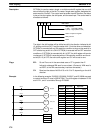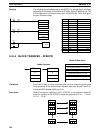
180
5-16 Data Movement
This section describes the instructions used for moving data between different
addresses in data areas. These movements can be programmed to be within
the same data area or between different data areas. Data movement is essential
for utilizing all of the data areas of the PC. Effective communications in Link Sys-
tems also requires data movement. All of these instructions change only the
content of the words to which data is being moved, i.e., the content of source
words is the same before and after execution of any of the data movement
instructions.
5-16-1 MOVE – MOV(21)
S: Source word
IR, SR, AR, DM, HR, TC, LR, #
D: Destination word
IR, SR, AR, DM, HR, LR
Ladder Symbols Operand Data Areas
MOV(21)
S
D
@MOV(21)
S
D
Description When the execution condition is OFF, MOV(21) is not executed. When the
execution condition is ON, MOV(21) copies the content of S to D.
Source word Destination word
Bit status
not changed.
Precautions TC numbers cannot be designated as D to change the PV of the timer or counter.
You can, however, easily change the PV of a timer or a counter by using
BSET(71).
Flags ER: Indirectly addressed DM word is non-existent. (Content of DM word is
not BCD, or the DM area boundary has been exceeded.)
EQ: ON when all zeros are transferred to D.
N: ON when bit 15 of D is set to 1.
5-16-2 MOVE NOT – MVN(22)
S: Source word
IR, SR, AR, DM, HR, TC, LR, #
D: Destination word
IR, SR, AR, DM, HR, LR
Ladder Symbols Operand Data Areas
MVN(22)
S
D
@MVN(22)
S
D
Description When the execution condition is OFF, MVN(22) is not executed. When the
execution condition is ON, MVN(22) transfers the inverted content of S (speci-
fied word or four-digit hexadecimal constant) to D, i.e., for each ON bit in S, the
corresponding bit in D is turned OFF, and for each OFF bit in S, the correspond-
ing bit in D is turned ON.
Source word Destination word
Bit status
inverted.
Data Movement Section 5-16


















